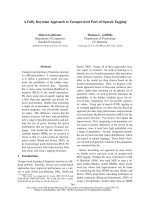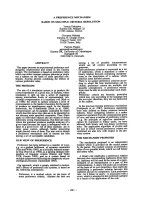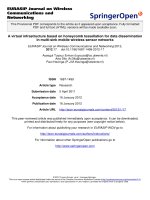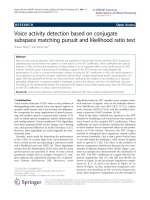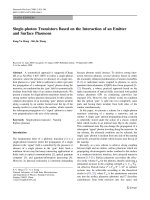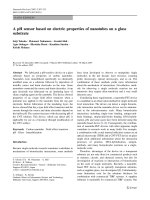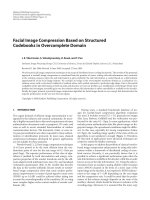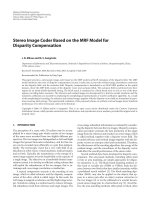Báo cáo toán học: "A short proof, based on mixed volumes, of Liggett’s theorem on the convolution of ultra-logconcave sequences" docx
Bạn đang xem bản rút gọn của tài liệu. Xem và tải ngay bản đầy đủ của tài liệu tại đây (88.04 KB, 5 trang )
A short proof, based on mixed volumes, of
Liggett’s theorem on the convolution of
ultra-logconcave sequences
Leonid Gurvits
Los Alamos National Laboratory
Submitted: Aug 19, 2008; Accepted: Feb 10, 2009; Published: Feb 13, 2009
Mathematics Subject Classification: 05E99
Abstract
R. Pemantle conjectured, and T. M. Liggett proved in 1997, that the convolution
of two ultra-logconcave is ultra-logconcave. Liggett’s proof is elementary but long.
We present here a short proof, based on the mixed volume of convex sets.
1 Introduction
Let a = (a
0
, , a
m
) and b = (b
0
, , b
n
) be two real sequences. Their convolution c = a b
is defined as c
k
=
i+j=k
a
i
b
j
, 0 ≤ k ≤ n + m. A nonnegative sequence a = (a
0
, , a
m
) is
said to be logconcave if
a
2
i
≥ a
i−1
a
i+1
, 1 ≤ i ≤ m − 1. (1)
Following Permantle and [5], we say that a nonnegative sequence a = (a
0
, , a
m
) is
ultra-logconcave of order d ≥ m (ULC(d)) if the sequence
a
i
(
d
i
)
, 0 ≤ i ≤ m is logconcave,
i.e.
a
i
d
i
2
≥
a
i−1
d
i−1
a
i+1
d
i+1
, 1 ≤ i ≤ m − 1. (2)
The next result was conjectured by R. Pemantle and proved by T.M. Liggett in 1997 [5].
Theorem 1.1: The convolution of a ULC(l) sequence a and a ULC(d) sequence b is
ULC(l + d).
Remark 1.2: It is easy to see, by a standard perturbation argument, that it is sufficient
to consider a positive case:
a = (a
0
, , a
l
); a
i
> 0, 0 ≤ i ≤ l and b = (b
0
, , b
d
); b
i
> 0, 0 ≤ i ≤ d.
the electronic journal of combinatorics 16 (2009), #N5 1
The (relatively simple) fact that the convolution of logconcave sequences is also logconcave
was proved in [3] in 1949.
We present in this paper a short proof of Theorem(1.1).
2 The Minkowski sum and the mixed volume
2.1 The Minkowski sum
Definition 2.1:
1. Let K
1
, K
2
⊂ R
n
be two subsets of the Euclidean space R
n
. Their Minkowski sum
is defined as
K
1
+ K
2
= {X + Y : X ∈ K
1
, Y ∈ K
2
}.
The Minkowski sum is obviously commutative, i.e K
1
+ K
2
= K
2
+ K
1
, and asso-
ciative, i.e
K
1
+ K
2
+ K
3
= K
1
+ (K
2
+ K
3
).
2. Let A ⊂ R
l
, B ⊂ R
d
. Their cartesian product is defined as
A × B := {(X, Y ) ∈ R
l+d
: X ∈ A, Y ∈ B}.
Define the next two subsets of R
l+d
:
Lift
1
(A) = {(X, 0) ∈ R
l+d
: X ∈ A}, Lift
2
(B) = {(0, Y ) ∈ R
l+d
: Y ∈ B}. (3)
Then the next set equalities holds:
A × B = Lift
1
(A) + Lift
2
(B). (4)
The next simple fact will be used below.
Fact 2.2: Let K
1
, K
2
⊂ R
l
and C
1
, C
2
⊂ R
d
.
Define the next two subsets of R
l+d
:
P = K
1
× C
1
, Q = K
2
× C
2
.
Then the following set equality holds:
tP + Q = (tK
1
+ K
2
) × (tC
1
+ C
2
), t ∈ R. (5)
Proof: Using (4), we get that
(tK
1
+ K
2
) × (tC
1
+ C
2
) = Lift
1
(tK
1
+ K
2
) + Lift
2
(tC
1
+ C
2
).
It follows from the definition (3) that
Lift
1
(tK
1
+ K
2
) = tLift
1
(K
1
) + Lift
1
(K
2
); Lif t
2
(tC
1
+ C
2
) = tLift
2
(C
1
) + Lift
2
(C
2
).
Therefore, we get by the associativity and commutativity of the Minkowski sum that
(tK
1
+ K
2
) × (tC
1
+ C
2
) = t(Lif t
1
(K
1
) + Lift
2
(C
1
)) + (Lift
1
(K
2
) + Lift
2
(C
2
)) = tP + Q.
the electronic journal of combinatorics 16 (2009), #N5 2
2.2 The mixed volume
Let K = (K
1
, , K
n
) be a n-tuple of convex compact subsets in the Euclidean space
R
n
, and let V
n
(·) be the Euclidean volume in R
n
. It is a well-known result of Herman
Minkowski (see for instance [2]), that the functional V
n
(λ
1
K
1
+ · · · + λ
n
K
n
) is a ho-
mogeneous polynomial of degree n with nonnegative coefficients, called the Minkowski
polynomial. Here
+
denotes Minkowski sum, and λK denotes the dilatation of K with
coefficient λ ≥ 0. The coefficient V (K) =: (V (K
1
, , K
n
) of λ
1
· λ
2
. . . · λ
n
is called the
mixed volume of K
1
, , K
n
. Alternatively,
V (K
1
, , K
n
) =
∂
n
∂λ
1
∂λ
n
V
n
(λ
1
K
1
+ · · · + λ
n
K
n
),
and
V
n
(λ
1
K
1
+ · · · + λ
n
K
n
) =
r
1
+···+r
n
=n
V (K
r
1
, ,r
n
)
1≤i≤n
r
i
!
(
1≤i≤n
λ
r
i
i
), (6)
where the n-tuple K
r
1
, ,r
n
consists of r
i
copies of K
i
, 1 ≤ i ≤ n.
The Alexandrov-Fenchel inequalities [1], [2] state that
V (K
1
, K
2
, K
3
, , K
n
)
2
≥ V (K
1
, K
1
, K
3
, , K
n
)V (K
2
, K
2
, K
3
, , K
n
). (7)
It follows from (6) that if P, Q ⊂ R
n
are convex compact sets then
V ol
n
(tP + Q) =
0≤i≤n
a
i
t
i
, t ≥ 0;
where a
0
= V ol
n
(Q) =
1
n!
V (Q, · · · , Q), a
1
=
1
(n−1)!1!
V (P, Q, · · · , Q), . . ., a
n
= V ol
n
(Q) =
1
n!
V (P, · · · , P ).
Using the Alexandrov-Fenchel inequalities (7) we see that the sequence (a
0
, , a
n
) is
ULC(n).
The next remarkable result was proved by G.S. Shephard in 1960:
Theorem 2.3: A sequence (a
0
, , a
n
) is ULC(n) if and only if there exist two convex
compact sets P, Q ⊂ R
n
such that
0≤i≤n
a
i
t
i
= V ol
n
(tP + Q), t ≥ 0.
Remark 2.4: The “if” part in Theorem(2.3), which is a particular case of the Alexandrov-
Fenchel inequalities, is not simple, but was proved seventy years ago [1]. The proof of the
“only if” part in Theorem(2.3) is not difficult and short. G.S. Shephard first considers the
case of positive coefficients, which is already sufficient for our application. In this positive
the electronic journal of combinatorics 16 (2009), #N5 3
case one chooses Q = {(x
1
, , x
n
) :
1≤i≤n
x
i
≤ 1; x
i
≥ 0}. In other words, the set Q is
the standard simplex in R
n
. And the convex compact set
P = Diag(λ
1
, , λ
n
)Q = {(x
1
, , x
n
) :
1≤j≤n
x
j
λ
j
≤ 1; x
i
≥ 0}; λ
1
≥ ≥ λ
n
> 0.
The general nonnegative case is handled by the topological theory of convex compact
subsets.
3 Our proof of Theorem(1.1)
Proof: Let a = (a
0
, , a
l
) be ULC(l) and b = (b
0
, , b
d
) be ULC(d). Define two
univariate polynomials R
1
(t) =
0≤i≤l
a
i
t
i
and R
2
(t) =
0≤j≤c
a
i
t
j
.
Then the polynomial R
1
(t)R
2
(t) := R
3
(t) =
0≤k≤l+d
c
k
t
k
, where the sequence
c = (c
0
, , c
l+d
) is the convolution, c = a b.
It follows from the “only if”!p part of Theorem(2.3) that
R
1
(t) = V ol
l
(tK
1
+ K
2
) and R
2
(t) = V ol
d
(tC
1
+ C
2
),
where K
1
, K
2
, C
1
, C
2
are convex compact sets; K
1
, K
2
⊂ R
l
and C
1
, C
2
⊂ R
d
.
Define the next two convex compact subsets of R
l+d
:
P = K
1
× C
1
and Q = K
2
× C
2
.
Here the cartesian product A × B of two subsets A ⊂ R
l
and B ⊂ R
d
is defined as
A × B := {(X, Y ) ∈ R
l+d
: X ∈ A, Y ∈ B}.
By Fact(2.2), the Minkowski sum tP + Q = (tK
1
+ K
2
) × (tC
1
+ C
2
), t ≥ 0.
It follows that V ol
l
(tK
1
+K
2
)V ol
d
(tC
1
+C
2
) = V ol
l+d
(tP +Q). Therefore the polynomial
R
3
(t) = V ol
l+d
(tP + Q).
Finally, we get from the Alexandrov-Fenchel inequalities (the “if” part of Theorem(2.3))
that the sequence of its coefficients c = a b is ULC(l + d).
4 Final comments
1. Theorem(2.3) and a simple Fact(2.2) allowed us to use very basic (but powerful)
representation of the convolution in terms of the product of the corresponding poly-
nomials. The original Liggett’s proof does not rely on this representation.
2. Let a = (a
0
, , a
m
) be a real sequence, satisfying the Newton inequalities (2) of
order m. I.e. we dropped the condition of nonnegativity from the definition of
ultra-logconcavity. It is not true that c = a a satisfies the Newton inequalities of
order 2m.
the electronic journal of combinatorics 16 (2009), #N5 4
Indeed, consider a = (1, a, 0, −b, 1), where a, b > 0 . This real sequence clearly
satisfies the Newton inequalities of order 4.
It follows that c
6
= b
2
, c
5
= 2a, c
4
= 2(1 − ab) and the number
c
2
5
c
4
c
6
= 2
a
2
b
2
(1 − ab)
converges to zero if the positive numbers a, b,
a
b
converge to zero.
3. The reader can find further implications (and their generalizations) of Theorem(2.3)
in [4].
Acknowledgements
The author is indebted to the both anonymous reviewers for a careful and thoughtful
reading of the original version of this paper. Their corrections and suggestions are reflected
in the current version.
I would like to thank the U.S. DOE for financial support through Los Alamos National
Laboratory’s LDRD program.
References
[1] A. Aleksandrov, On the theory of mixed volumes of convex bodies, IV, Mixed dis-
criminants and mixed volumes (in Russian), Mat. Sb. (N.S.) 3 (1938), 227-251.
[2] Yu. D. Burago and V. A. Zalgaller, Geometric Inequalities, Springer-Verlag, 1988.
[3] H. Davenport and G. Polya, On the products of two power series, Canad. J. Math.
1(1949), 1-5.
[4] L. Gurvits, On multivariate Newton(like) inequalities, available at
2008.
[5] T. M. Ligggett, Ultra Logconcave sequences and Negative dependence, Journal of
Combinatorial Theory, Series A 79, 315-325, 1997.
[6] G. C. Shephard, Inequalities between mixed volumes of convex sets, Mathematika 7
(1960) , 125-138.
the electronic journal of combinatorics 16 (2009), #N5 5
